
The LONDON TRANSPORT RT FAMILY: ROOFBOX RTs
This page updated 23rd October 2006: best on 800*600
All photos on this page are by Ian Smith, and most can be clicked to see larger versions.
RT152 onwards (Total 1169)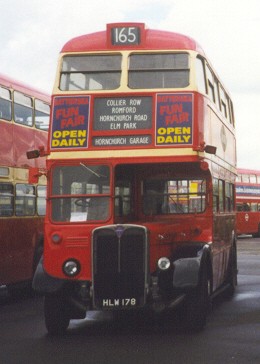
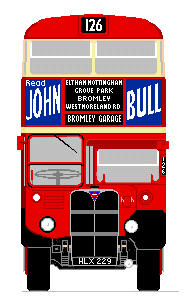
The post-war RT was not so much a bus as a way of life for London Transport after the war. That event had given LT an enforced break from bus procurement, apart from the utility designs. This did at least give them the chance to evaluate RT1 and the wooden-framed RT2s in service, and to mull over what they really wanted. That was a standard bus. Once the war was over there would need to be almost a clean sweep of the Augean stables. Many types should have gone in 1940 - the rest of the open staircase STLs and TDs, for instance. The austerity types were not seen as having much future with LT either. The STLs, too, were suffering badly from an extended life-span and wartime maintenance. So why not replace them all? With a truly standard double-decker LT could extend its pre-war practice of keeping a float of spare bodies, and develop its overhaul practice around it. Thus was born not just the idea of the RT, with its separate body and chassis, but the concept of Aldenham Works. RT3: roof-box, deep valance, rectangular mirrors, pillar plate. RT191 at North Weald, June 1998, with trafficators.
LT had a spare tube train maintenance depot,
built at Aldenham for the never-completed extension of the Northern line.
This was converted into a bus overhaul plant.
When an RT arrived, the body and chassis were separated,
and went onto separate overhaul lines.
Everything was checked.
ConstructionIntroduced:1946Chassis: Type 3RT: AEC Regent III, 16ft 4in wheel-base, 6 cylinder 9.6 litre diesel Bodies: Park Royal, Weymann, type RT3: 56 seats (26 + 30), metal frames, 4 bays.
The roofbox bodies fitted to the early postwar RTs looked much like the wartime RT2 body.
They were actually much more like the body on the prototype RT1,
in that they had metal frames.
The setup of the postwar production lines was delayed
while the jigs for these were made,
so the first post-war production of RTs was actually for other companies:
the "Provincial RTs", using traditional bodywork construction.
Early Park Royal / Weymann 3RT3 roofbox RT, with no offside route plate, deep valance and nearside pillar route plate.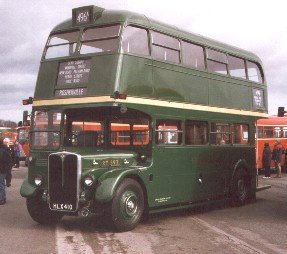 But visually they were much the same as the war-time RTs, apart from a few give-aways:
But visually they were much the same as the war-time RTs, apart from a few give-aways:
RT593 at the Cobham Open Day April 1998
preserved in the 1950 standard livery of green with a single cream band.
The first few from Park Royal had no offside route indicator panel, a carry-over from wartime practice, but this was in place on the Weymanns and later Park Royals. Those built without it had it installed at overhaul - in time for a further policy change against their use! During the planning for RT production it was realised that 1948 would be a doubly-difficult year. Many old buses would have to come off the road that year, but Weymann and Park Royal were already committed to full production (including RTs). Other body-builders were approached to see if smallish numbers of stop-gap bodies could be sourced (AEC could supply enough chassis). Successful bidders were Cravens of Sheffield, who built 120 distinctly non-standard buses - the Cravens RTs, and Saunders of Anglesey, who built 300 almost standard roofbox buses - the Saunders RTs.
Service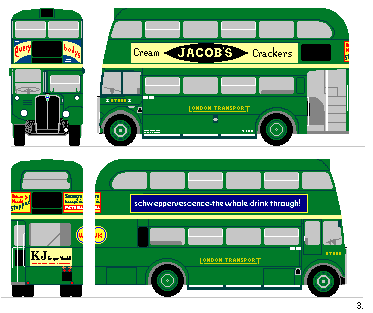 The first RT3 delivered was RT 402, bodied by Weymann, on the 10th of May 1947.
Park Royal's RT152 appeared on 23rd May 1947.
Both went to Leyton to replace open-staircase LTs.
The livery for the new buses was red overall,
with cream surrounds to the upper windows and a cream cant-rail band.
Mudguards and guard-rails were black.
The first RT3 delivered was RT 402, bodied by Weymann, on the 10th of May 1947.
Park Royal's RT152 appeared on 23rd May 1947.
Both went to Leyton to replace open-staircase LTs.
The livery for the new buses was red overall,
with cream surrounds to the upper windows and a cream cant-rail band.
Mudguards and guard-rails were black.
The Country Area did not have very long to wait for the start of its share. Traditionally the receiver of hand-me-downs from the Central Area, it had an awful collection of odds and ends to contend with after the war. Now it was to receive the flagship bus, starting in July 1948, at Hemel Hempstead (Two Waters) and Tring. Livery was green, with cream upper window surrounds and band. The Country buses had identical fittings, including the offside route board, but this was seldom used after the first few days, as Country buses commonly were used on a variety of routes in each duty. Park-Royal or Weymann roofbox RT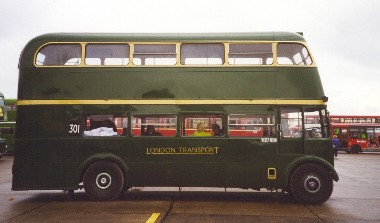
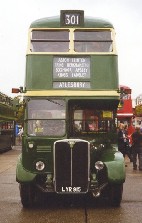
RT3496 is seen in preservation at Showbus 98. It now wears early green and cream livery.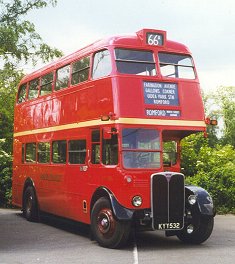 The new red and green buses received an enthusiastic welcome from both staff and public.
This was a nice bus to ride - or work- in.
The new red and green buses received an enthusiastic welcome from both staff and public.
This was a nice bus to ride - or work- in.
The livery was changed in 1950, the cream window surrounds disappearing from both liveries. The RTs settled down to many years hard service, and some adventures. One RT jumped the gap in Tower Bridge one day: the bridge started to open as the bus was crossing! RTs turned up in all sorts of unlikely places - but reports of a London RT being found on the Moon are apocryphal! But not all the RTs had roofboxes. Prewar RTs 46 and 110 (which had lost its front roofbox), had taken part during 1946 in trials for various patterns of front display. The non-roofbox display was preferred, and so the production of roofbox RTs was limited to those already ordered. Later RTs were to have a 3-panel front display, without a roofbox: the standard RTs.
RT1705 immaculate in red at the RT60 rally, Stoke d'Abernon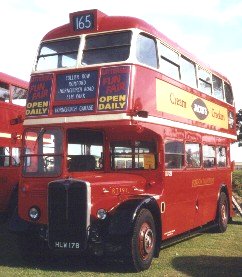 But some of the changes also affected the later roofbox RTs:
early RT3s had no offside route-number provision,
and this was remedied very early in production.
They also had no route number box under the front canopy,
just a narrow vertical board with the route number on the front nearside pillar,
which was was often not used.
For the last 100 roofbox buses from Park Royal, and the last 50 from Weymann,
there was an illuminated under-canopy display on the nearside.
To help waiting passengers to see this, the front valance, below the cream band,
was cut away , producing a better balanced look to the front end in the process.
The vacated position on the front pillar was used for a housing for a semaphore arm,
although these were not fitted.
The offside arm housing was behind the drivers door.
These 150 bodies were classified RT10.
But some of the changes also affected the later roofbox RTs:
early RT3s had no offside route-number provision,
and this was remedied very early in production.
They also had no route number box under the front canopy,
just a narrow vertical board with the route number on the front nearside pillar,
which was was often not used.
For the last 100 roofbox buses from Park Royal, and the last 50 from Weymann,
there was an illuminated under-canopy display on the nearside.
To help waiting passengers to see this, the front valance, below the cream band,
was cut away , producing a better balanced look to the front end in the process.
The vacated position on the front pillar was used for a housing for a semaphore arm,
although these were not fitted.
The offside arm housing was behind the drivers door.
These 150 bodies were classified RT10.
The last roofbox RT delivered was Saunders RT 4267, to Streatham in February 1951.
Overhauls and Standardisation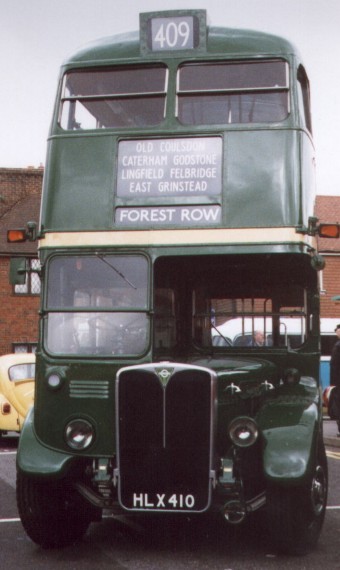
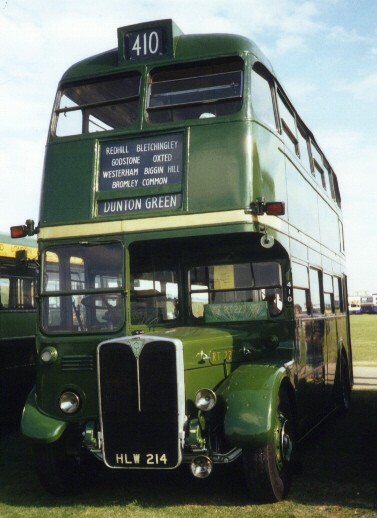 The 1952 overhaul round saw the roofbox buses largely receive overhauls without body exchanges.
But by 1956 Aldenham was ready for them.
But the early buses were going in for second overhaul as later buses went for their first,
so very rapidly roofbox bodies started to appear on high-numbered buses.
The 1952 overhaul round saw the roofbox buses largely receive overhauls without body exchanges.
But by 1956 Aldenham was ready for them.
But the early buses were going in for second overhaul as later buses went for their first,
so very rapidly roofbox bodies started to appear on high-numbered buses.
Eventually London Transport realised that it had too many RTs.
The rise of the motor car had begun.
In 1956 the non-standard Cravens RTs went for sale,
and in 1958 fifty surplus ordinary RTs went (half of them to Bradford).
Early sales were of low-numbered RTs, but because of the Aldenham system
they were not necessarily the oldest buses.
Some standard RT8s and Saunders RT3/3s were sold in that first batch.
The error was soon noticed!
Once all the trolleybuses had been replaced (mostly by RMs)
the RT classes once more became the target for replacement.
But this time the process was more rational, with buses selected for disposal
on the basis of age or damage. The RT3 roofbox bodies were high on the hit list,
as were the Leyland-chassis RTLs. Many went to South Africa for the Cape Electric Tramways,
and whole shiploads went to Ceylon.
As for longevity: there is still a roofbox RT running in daily public service, in London Transport red livery,
at the University of Davis in California!
RT1784 at Stoke d'Abernon for RT60, 6 June 1999BuildersThe roof-box bodies as built:
Green in the City: RT593 at Aldwych at the start of RT60Preserved Park Royal or Weymann roofbox RTs(Please let me know of any others not mentioned):RT 172 HLW 159 2008 preserved: T.Leighton, Keighley: in Bradford blue/cream RT 190 HLW 177 2008 ex-RT1173, preserved: T.Stubbington & A.Peters RT 191 HLW 178 2008 preserved, C.Scott, Romford RT 227 HLW 214 2008 preserved, with rear doors, green: C.Mudie, Ponterwyd RT 329 HLX 146 2008 preserved, P.Dale, Sherborne RT 593 HLX 410 2008 preserved, green: P.Plummer & G.Townsend, Cobham RT 935 JXN 325 2008 preserved (minus roofbox): B.Garrad & R.Smith, Basingstoke 
RT935, rebuilt with a standard front, awaiting some new blinds, at Cobham Open day 98. Photo by Ian Smith. Click for a larger version.RT1173 see RT190 RT1705 KYY 532 2008 preserved: W.Ackroyd & A.Evans RT1784 KYY 622 2008 preserved: G.&J.Hinson, Northampton RT2553 LYF 278 2008 film work, in store, Men at Work, Hanwell RT2657 LYR 641 preserved, static, in AMTUIR Museum, Paris (60, Avenue Saint Mande) RT2827 LYR 997 2008 preserved by K.Batten, Castle Point Museum: Osbournes livery RT3496 LYR 915 2008 preserved in green and cream: P.Dale, Sherborne RT4325 NLE 989 2008 in rebuild by RT824 Group, High Wycombe 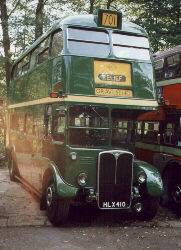
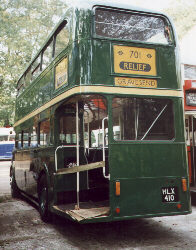 RT 593 in preservation at Cobham, October 1997.
RT 593 in preservation at Cobham, October 1997.Extra indicators have been fitted at the rear to comply with modern requirements - one of the problems of active preservation. Photos by Ian Smith.  photo references.
photo references.
 bus histories.
bus histories.
 Cravens RTs
Cravens RTs
 Saunders RTs
Saunders RTs
 standard RTs
standard RTs
|
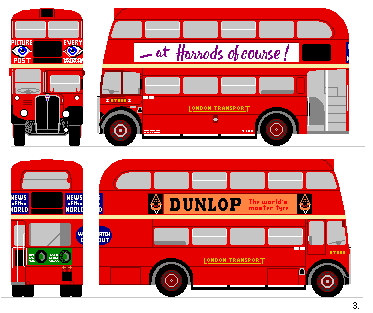
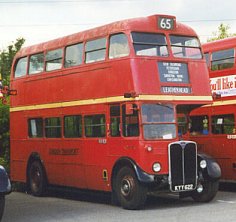

 Ian's Bus Stop
Ian's Bus Stop RT contents
RT contents wartime RTs
wartime RTs roofbox RTs
roofbox RTs